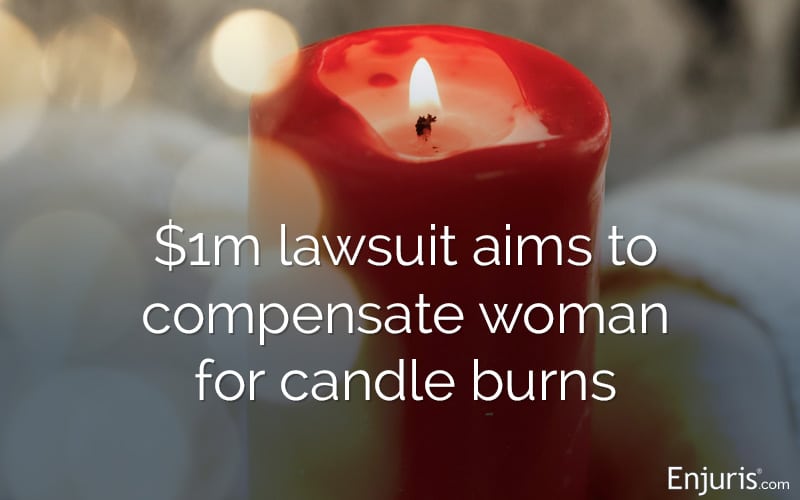
Texas woman suffers severe burns after candle glass shatters, scalding her with hot wax
The manufacturer of a luxury candle is being sued because the product’s enclosure shattered after the flames were out of control, leaving a customer seriously injured.
RickiLynn Gardner was getting ready for Christmas. Even though a white Christmas was likely not a thought in her Seabrook, Texas community, she was doing what she could to bring warm scents and Christmas tidings to her home.
She purchased a $150 three-wick candle called Deluxe Midnight in Paris made by Aroma360, which is the parent company of the Hotel Collection. It had an inviting scent and she thought it would add a lovely Christmas ambiance to her house. But when she lit the candle, flames shot up about eight inches. Gardner was nervous and surprised, so she waited a moment for the flames to settle and then moved the candle to her sink, thinking she would extinguish it there. However, when she tried to move the candle, the flames shot up again and the outer glass on the jar shattered. The wax burned her hands. When the lawsuit was filed in July 2023, Gardner was still recovering from her burns in November 2022.
Gardner filed a $1 million lawsuit against Aroma360, claiming that the candle was “unreasonably dangerous” and that she had used it exactly as it was intended.
Her lawsuit was filed in Texas federal court for design, marketing and manufacturing defects, along with negligence.
Gardner said that when the candle arrived, the box contained no instructions. However, there was a warning “in tiny print” at the bottom of the candle that advised against picking it up or extinguishing it with water.
However, when she lit it for the first time just after Thanksgiving, she said it “became like a bonfire on my kitchen counter.” She knew she had to put it out. There was no lid, so she tried to extinguish the fire with water. That didn’t work. She couldn’t find baking soda, so she tries to blow out the flames. They settled a little, but not enough. Still concerned, Gardner decided to move it to the sink. She touched the class container that held the candle, and it was cool to the touch—and then it shattered.
After the hot wax spilled onto her hands, Gardner ran to the garage to retrieve her fire extinguisher. However, she could not operate the extinguisher because of the injury to her hands. She finally extinguished the candle with a wet towel, and Gardner left her house when her mother arrived to drive her for medical treatment for the burns. The incident was captured on her home’s Blink camera video surveillance system.
After the burns
Garder received skin grafts and wears gloves to protect what is now delicate skin on her hands. Her lawsuit references social media posts and online reviews from purchasers of Aroma360 candles who also experienced intense flames and shattered glass while using the manufacturer’s product. The company continues to sell these candles, even though the lawsuit says it has a “conscious disregard” for its customers’ safety.
Gardner has a hard time completing everyday chores, like cooking and driving. She is unable to participate in her 9-year-old daughter’s activities like she used to do, like helping out with her cheer team. She has developed a fear of fire and candles.
Product liability lawsuit
A lawsuit related to a defective item is a product liability claim. This can be for any item that you’ve purchased or acquired that causes an injury when used in the manner it was intended or in any way that the manufacturer would reasonably anticipate.
There are three types of product liability claims:
1. Design defect
The first step in any production process for an item is the design. A design defect means that even when manufactured exactly according to a product’s specifications, a flaw makes it unsafe to use.
2. Manufacturing defect
Sometimes, a product’s design is great but something goes awry during production. For example, something like a screw loose, substituted materials, cracked structure, etc. can make something harmful that would otherwise be safe. It’s “broken” before it even leaves the manufacturing plant.
3. Failure to warn/marketing defect
A manufacturer is responsible for ensuring that the item is labeled with correct use instructions and proper warnings about uses that could make it hazardous. Often, these are on tags or package inserts.
Proving a defective product claim
In a product liability suit, the plaintiff has to prove four things in order to successfully recover damages:
- They were injured and suffered a loss.
- The product was defective in some way.
- That specific product was the actual and proximate cause of injury.
- They were using the product as intended and as a reasonable person would use it.
It seems clear that RickiLynn Gardner’s case meets these criteria, but the claim is still pending in the court system. If you’ve suffered an injury from a defective product, contact a personal injury lawyer for more information on your legal options.
Fitbit Recall for Burn Injuries Leads to Class Action Lawsuit
Explore details of the lawsuit against Fitbit over burn injuries, highlighting consumer safety concerns and the implications for the wearable tech industry.

